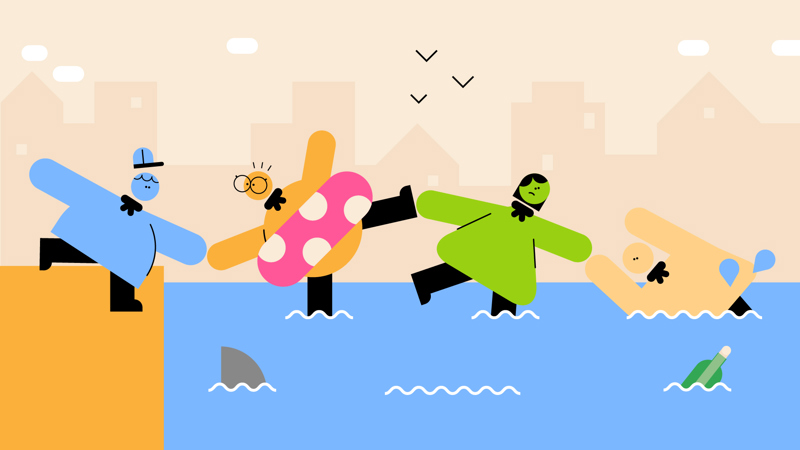
Rescue mission
- Form small ‘rescue teams’, and assign each rescue team one castaway.
- Rescue teams should stand at one side of the room; their castaway should stand at the opposite side of the room, facing the rescue team. The distance between the castaway and the safe zone should be large enough to challenge the team, but small enough that each team can definitely reach the other side.
- The flash flood has now begun. Teams must link together to form a human chain, holding onto a piece of each other’s clothing, a hand, or a leg.
- To complete the rescue mission, each team must cross the waters, collect their castaway, and return to the safe zone – all without breaking the human chain.
- Everyone should get back together and chat about how it went. What did they do to be a good team player and help their team? Can they think of other types of teams and the roles in them?
Whilst playing, remember:
- At least one member of the rescue team chain must be connected to the safe zone at all times.
- If team members let go of the chain attaching them to the safe zone, they will float away.
- Each member of the rescue team can only have two parts of their body in the water (touching the floor) at a time.
- Each player must have a different pair of body parts in the water – if someone has their foot and knee in the water, no other player can use that combination of body parts.
Reflection
After each attempt, teams should reflect on their rescue, and the skills they used to rescue their castaway. A great rescue relies on great teamwork– how did you communicate? Were you patient? How did you cooperate? Did you check in with your team to see if anyone felt wobbly or needed extra support?
A successful rescue also relies on your problem-solving skills – how did you plan ahead? What was the most difficult bit, and how did you manage it? How did you make decisions about what to do?
Safety
All activities must be safely managed. You must complete a thorough risk assessment and take appropriate steps to reduce risk. Use the safety checklist to help you plan and risk assess your activity. Always get approval for the activity, and have suitable supervision and an InTouch process.
- Active games
The game area should be free of hazards. Explain the rules of the game clearly and have a clear way to communicate that the game must stop when needed. Take a look at our guidance on running active games safely.
- Play as a whole group, without splitting into teams. Create obstacles (using tables, chairs, or games equipment) which this bigger team must navigate around.
- Create live distractions during the rescue mission, by rolling soft balls across the room like debris across the water.
- Increase the number of body parts team members can have in the water (touching the floor).
- Team members could ‘buddy up’, and balance in a pair if anyone needs a little extra support in the chain. Remember to change the distance between the safe zone and the castaway if any players will be next to each other, as their team won’t be able to reach as far.
- Mark out stepping stones on the floor for teams to use, so they don’t have to plan a route. Now they only have to focus on their bodies and balance.
All Scout activities should be inclusive and accessible.
Flash floods are only one danger people might need rescuing from – a rescue mission could also help people after an earthquake or landslide. You could link this game to your Beavers or Cubs Global Issues Activity Badge, using it to introduce the idea of a disaster, and what an international charity might do to help.

